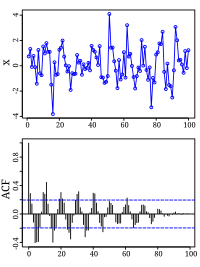
Photo from wikipedia
Arrays with low autocorrelation are widely sought in applications; important examples are arrays whose periodic autocorrelation is zero for all nontrivial cyclic shifts, so-called perfect arrays. In 2001, Arasu and… Click to show full abstract
Arrays with low autocorrelation are widely sought in applications; important examples are arrays whose periodic autocorrelation is zero for all nontrivial cyclic shifts, so-called perfect arrays. In 2001, Arasu and de Launey defined almost perfect arrays: these have size 2u×v and autocorrelation arrays with only two nonzero entries, namely 2uv and −2uv in positions (0,0) and (u,0), respectively. In this paper we present a new class of arrays with low autocorrelation: for an integer n≥1, we call an array n-perfect if it has size nu×v and if its autocorrelation array has only n nonzero entries, namely nuvλi in position (iu,0) for i=0,1,…,n−1, where λ is a primitive n-th root of unity. Thus, an array is 1-perfect (2-perfect) if and only if it is (almost) perfect. We give examples and describe a recursive construction of families of n-perfect arrays of increasing size.
Journal Title: Cryptography and Communications
Year Published: 2017
Link to full text (if available)
Share on Social Media: Sign Up to like & get
recommendations!